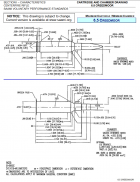Not the best, but better than nothing.
I don’t know if you have ever looked at the drawings for the cartridge and chambers, they are below.
In both drawings on the shoulder is a length at the diameter of .400”. This will be headspace. A 40 .caliber case would have that diameter, or be much closer than a fired 9mm of about .360. You can expand the 9mm a bit, maybe beg borrow or steal a 40 s&w. Pretty common round.
Place the case upside down on the shoulder of you fired and sized cases. The difference will be how far it grew under firing or how much you sized it. The smaller diameter won’t give you a true reading, but will work for comparing the to different numbers.
Next number will be bore diameter, .256”. If you size a piece of 6.5 brass without the expander and check diameter, it will probably be around .259”. Again a bit off but using that the same as the 9mm case you will be able to measure cartridge base to bullet ogive on a loaded round. That will be your make shift comparator set for now.
If you can come up with a 25 caliber case, it will have a much closer actual diameter for an exact measurement,
Even with the wrong diameter, it’s will allow you to measure where that bullet would hit the rifling in your chamber and insure you are not hitting the lands.
Now you have the comparator set people have told you is a must.
I gave you the link to bullet lengths, it’s not perfect due to lot to lot variation, but it’s enough to keep you safe.
Case length + bullet length - COL = seated depth.
Case length + bullet length - seated depth = COL.
Or just use the difference in bullet length to adjust seated depth to keep the load density the same. A bullet .100” longer needs to be seated .100” longer, and needs to be off the lands to prevent higher pressures.
There are plenty of threads explaining different ways how to find the lands. You now have the tools and measurements to keep yourself safe, better tools will of course produce much more consistent rounds. For now it’s safety.
Hope that’s a bit of help.












